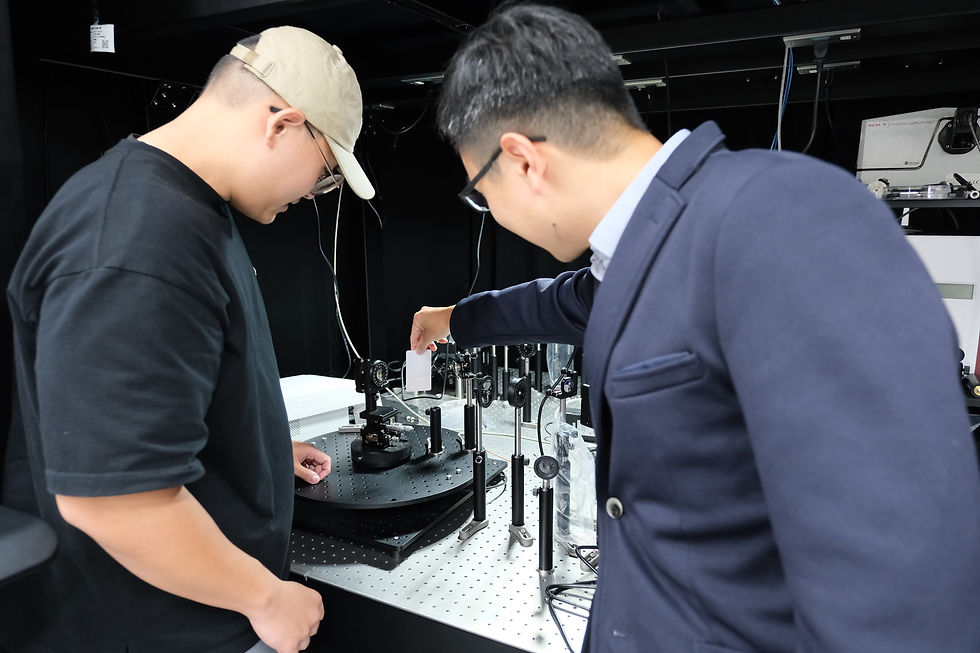Research Highlights on NYCU News
- Yao-Wei Huang
- Oct 25, 2024
- 3 min read
Updated: Dec 5, 2024
NYCU Unveils Groundbreaking Interface Technology to Revolutionize Anti-Counterfeiting Security for Credit Cards and Passports
From NYCU News
Translated by Szu-Yung Huang, Edited by Chance Lai
In a significant advancement for security technology, a research team led by Assistant Professor Yao-Wei Huang from the Department of Photonics at National Yang Ming Chiao Tung University (NYCU) has unveiled a novel metasurface interface technology. This breakthrough promises to significantly enhance the color performance of anti-counterfeiting labels, addressing current issues of limited color diversity and suboptimal chromatic dispersion. The innovation dramatically bolsters the security of critical identification documents such as credit cards and passports.

The research paper's first author, Huan-Teng Su (left), and Assistant Professor Yao-Wei Huang (right) discuss a schematic diagram in front of the measurement equipment.
The research, titled “Topology Optimization Enables High-Q Metasurface for Color Selectivity,” was featured as the cover story in the August edition of Nano Letters, drawing significant attention from academic and industrial sectors worldwide.
High-Q Metasurface Technology Elevates Color Purity and Efficiency in Anti-Counterfeiting Labels
This innovative anti-counterfeiting label was developed under the leadership of Assistant Professor Yao-Wei Huang, a Yushan Young Scholar. Traditional anti-counterfeiting technologies, like the holograms found on credit cards or Japan’s new currency, primarily rely on grating structures for light dispersion, which results in limited color presentation.

The team fabricated the metasurface samples using advanced semiconductor processing equipment at the Nano Facility Center. Electron microscope images reveal the structural morphology of portions of the sample.
Assistant Professor Huang explained that the newly developed narrowband metasurface technology operates within four narrow wavebands, displaying vivid red, yellow, green, and blue colors with exceptionally high purity. This level of color purity and angle-specific color rendering holds tremendous potential for applications in anti-counterfeiting labels.
The key to this innovation lies in a high-Q (high-quality factor) nonlocal metasurface, which resolves the inefficiencies associated with traditional techniques. Using a proprietary topology optimization inverse design method, the team designed a metasurface with an unprecedented quality factor of 1362. Experimental results showed a 15-fold increase in efficiency, reaching an experimental efficiency of 59%—a significant milestone in nonlocal metasurfaces.
A Fusion of Science and Art: A New Perspective on Optical Innovation

The metasurface samples display ultra-Q colors in red, yellow, cyan, and blue, resembling musical notes scattered across a spectral melody.
During the experiments, the research paper's team member and first author, Huan-Teng Su, captured a striking visual of the color transitions—red, yellow, cyan, and blue—within the metasurface. He aptly named this image "The Melody of Colors in High-Q Metasurfaces" and entered it into the 11th Tin Ka-ping Academic Digital Imaging Competition, where it earned recognition.
Su remarked that the image resembled musical notes decorating a spectral melody, with the vibrant colors resembling macarons, blending science, visual art, and optics into an inspiring exploration of light and color.
This research marks a breakthrough in anti-counterfeiting technology and showcases the harmonious intersection of science and art. Through precise technical development and innovative artistic presentation, Assistant Professor Huang and his team have enhanced the practical value of anti-counterfeiting labels and invited us to appreciate the intricate beauty of the optical world from a fresh perspective. This achievement will spark further exploration and discussion in academic and industrial circles, paving the way for limitless possibilities in future technological innovation.

A group photo of the research team.

Comments